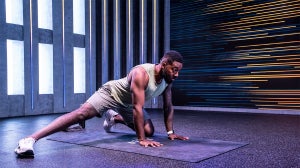
What Are Monster Walks?
Maybe you have seen serious athletes and hardcore fitness fanatics walking side to side like a crab with an elasticated band around their legs while you had been laboring under the notion that treadmills and squats were the only way to build your butt strength. First off, while the name ‘crab walk’ may seem a better-suited title, once you have tried them you will instantly see why they are actually called ‘monster walks’.
There are many virtues to monster walks, also known as band walks, but the main rewards include effectively toning your glutes and hips with only a small, simple piece of kit. They can be performed at home, too, meaning you needn’t splash out on a gym membership if you have specific goals in mind and a limited budget.

How You Do You Monster Walks?
Monster walks, to the average onlooker, are relatively simple looking exercises, but it is the engagement and forced, and the continuous tension of your muscles that make them so monstrous.
To perform monster walks you would commonly use a resistance band, or some form of elasticated binding around your ankles, feet, knees or upper legs, depending on the range of movement and level of resistance you would like to create.
- Standing in an upright position, squat slightly. Again, this is another variable element that will affect the difficulty (and results) of the exercise. For a good place to start, imagine yourself perching on an invisible chair with straight posture and slightly arched back.
- Keep your knees bent and your hands on your hips, or crossed over your chest so that you are not tempted to use your arms to balance or propel yourself.
- Walk with diagonal step, moving ahead and outwards, as opposed to side to side. While there are many arguments for walking with side steps, if you are using monster walks as a part of recovery for knee or hip injuries, this can place an unnatural strain on the sensitive joints, when it is the muscles that you ought to be working.
The secret, as we mentioned, is tension. You can tell that you are doing these effectively as you will feel the continued tension in your muscles and in the elastic band. If the band is slack or not as tight as it could be then the resistance is not great enough to get the most out of this exercise. Similarly, you should feel the same tension (or strain) in your muscles.
Your glutes, hamstrings, hips and outer legs should be feeling the burn at all times. If you are not feeling it in these places that could be because you are not squatting deep enough, that your knees are not bending enough, that your posture is incorrect, or that you are performing the exercise too quickly.
Further tips include looking out for your lower back. As with squats, if you are feeling too much strain on your lower back then you are not engaging your glutes, legs and core as much as you should be.
The slower the better. If you can’t tell whether or not you are performing these too quickly for them to be beneficial, you could try timing each step with a count of three Mississippi and then pause for one second between each step.
You could take these a step further by holding a slightly deeper squat between each step for a count of three, ensuring that you return to the right posture when you continue.
The lower the band is down your legs, ie, around your feet, the more difficult the exercise will be.

Benefits Of Monster Walk Exercise
Monster walks are a staple in many athlete and bodybuilders’ regimens for good reason: the results they yield. Monster walks are designed to activate the muscles in your hips and glutes.
The hip extensors and abductors play a majorly important role in the function of your kinetic chain. Popular alternatives for exercising these muscles, which are commonly found and seen in gyms, include side leg raises and the use of abductor and extensor machines (where you push out levers from a central position or squeeze inward with your knees). If you haven’t been doing these, or something similar, and have been relying on standard squats, leg presses and deadlifts to strengthen your legs, you may have been neglecting this vital muscles in your hips.
Not only do butt exercises like monster walks keep your rear toned and pert, if you don’t exercise your glutes regularly enough this can actually lead to musculoskeletal difficulties that can affect your posture and leave your back weak.
The foremost reason physiotherapists prescribe monster walks is their ability to strengthen your connective tissue. This can help to build your stability when running, walking and even just standing upright.

Alice Pearson is a UKVRN Registered Associate Nutritionist and UK Anti‐Doping accredited advisor, having obtained a Bachelor’s of Science in Nutrition and a Master’s of Science in Sport Nutrition. She has a specialist interest in the use of sports supplements for improving health, fitness, and sport performance. Alice has experience working with both amateur and elite athletes, including providing nutritional support to Tranmere Rovers FC and Newcastle Falcons Rugby Club. Her nutritional guidance is always supported by evidence‐based research, which she keeps up to date through continuing professional development and independent learning. In her spare time, Alice loves travelling, hitting the gym, and getting stuck into a good book. Find out more about Alice's story here.






